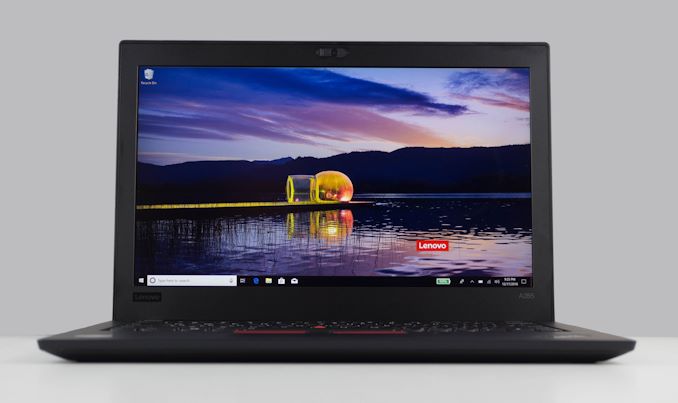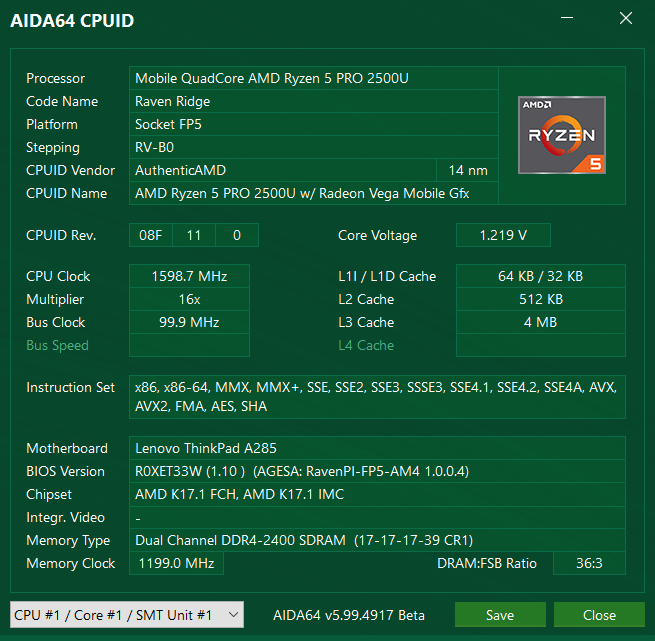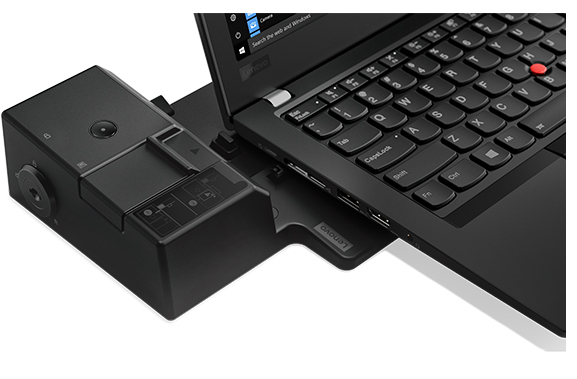The Lenovo ThinkPad A285 (12.5-Inch) Review: Ryzen Pro Gets Down to Business
by Brett Howse on December 18, 2018 8:00 AM EST- Posted in
- Laptops
- AMD
- Lenovo
- ThinkPad
- Vega
- Ryzen
- Ryzen PRO
- Ryzen Mobile
- Vega Mobile

A couple of months back Lenovo released the ThinkPad A285; a 12.5-inch business-class notebook featuring AMD’s Ryzen Pro mobile processor, complementing their 14-inch A485 Ryzen Pro powered model. These are the first two Lenovo ThinkPad models to feature AMD's Ryzen APU, and with it the latest generation of their Pro series, offering enhanced security, and manageability, over the normal consumer variants.
As it so happens, this is also our first time looking at a Ryzen Pro APU. So for those out of the loop on AMD's enterprise-focused parts, what's significant about Ryzen Pro? The Pro in Ryzen Pro is important for IT administrators, where manageability of devices is the key to keeping them secure and up to date. Ryzen Pro offers other features as well which will be of interest to the enterprise, such as a minimum of 24 months of planned availability of parts, meaning volume purchases should be able to maintain repairs and image stability.
Ryzen Pro also offers DRAM encryption as an option, which is OS and application agnostic, with a low performance impact. It also features an dTPM 2.0. And as a business-class device, it offers management via AMD’s implementation of Desktop and mobile Architecture for System Hardware, or DASH, which offers management tools such as the redirection of keyboard, video, and mouse (KVM), remote power-on, and other features for wide-scale device management.
Putting theory into practice, we have the subject of today's review: Lenovo's ThinkPad A285. The staunchy Lenovo laptop ships with AMD's Ryzen 5 Pro 2500U APU, which like its non-pro counterpart is a quad-core processor with eight threads, and a base frequency of 2.0 GHz with a boost frequency of 3.6 GHz. On the GPU side it offers 8 Vega GPU cores (CUs) as well, which is a step below the 10 cores offered on the fastest Ryzen Pro SKU, the Pro 7 2700U.
| Lenovo ThinkPad A285 | |||||
| As Tested: Ryzen 5 Pro 2500U, 8GB, 512 GB, 1080p | |||||
| CPU | AMD Ryzen 5 PRO 2500U 4C/8T, 2.0-3.6 GHz 15W TDP |
||||
| GPU | Vega 8 iGPU 512 SPs, 1.1 GHz |
||||
| RAM | 8 GB DDR4 Dual-Channel | ||||
| Display | 12.5-inch 1366x768 TN Optional 1920x1080 IPS anit-glare with multitouch |
||||
| Storage | 256-512 GB NVMe | ||||
| Networking | Realtek 8822BE Wireless 802.11ac 2x2:2 Realtek GbE (optional dongle required) |
||||
| Connectivity | USB 3.1 Gen 2 Type-C x 2 USB 3.1 Gen 2 Type-A x 1 USB 3.1 Gen 1 Type-A (always on) x 1 HDMI 2.0 Smart Card Reader (optional) Headset jack MicroSD |
||||
| Security | dTPM 2.0 ThinkShutter AMD GuardMI |
||||
| Windows Hello | Optional Fingerprint reader | ||||
| Battery | 48 Wh 65-Watt AC Adapter RapidCharge 80% in 60 minutes |
||||
| Dimensions | 308 x 210 x 17.4 mm 12.1 x 8.3 x 0.7 inches |
||||
| Weight | 1.26 kg / 2.78 lbs | ||||
| Price | Starting at $890.99 As tested: $1209.59 |
||||
Lenovo has been doing ThinkPads a long time, so the rest of the device fits in well with what businesses would be looking for. Unfortunately, the display Lenovo uses in their base model is a 1366x768 TN panel, but they do offer a proper 1920x1080 IPS model as well with touch. There’s also a fingerprint reader for Windows Hello, and the new ThinkShutter which can be slid over the webcam, which is a great privacy feature Lenovo has introduced.
The Thinkpad A285 offers plenty of connectivity for a small device, with two USB-C Gen 2 ports, one Type-A Gen 2 port, and one Type-A Gen 1 port which offers always-on power. There’s HDMI 2.0, and DisplayPort over USB-C. If you need to dock the laptop, Lenovo offers a couple of options including a USB-C dock. For those that need it, you can add-in a Smart Card reader as well.
On the network side, Lenovo offers an 802.11ac solution, as well as a dongle for a native Ethernet adapter, since laptops are generally too thin now to offer a full-size Ethernet port.
With a starting weight of 2.78 lbs, this ThinkPad is well equipped and should be easy to use on the go.












72 Comments
View All Comments
jardows2 - Tuesday, December 18, 2018 - link
This chassis is not too thin for an Ethernet port. Our organization just ordered in a bunch of HP probook 450's that are every bit as thin as this, and they all include an Ethernet port. To make Ethernet connectivity a dongle is just a stupid business decision made by Lenovo for this class of laptop.HStewart - Tuesday, December 18, 2018 - link
It not that thin of notebook, it include Type-A USB so it still fat notebook - I would think it possible to include ethernet at back part of it - probably a cost saving measure - just like the display.IGTrading - Tuesday, December 18, 2018 - link
I find it ridiculous that the reviewers felt the unexplained need of including 15" laptops and notebooks with a discrete video card and compared them with a 12.5" Thin&Light portable without a discrete GPU.Why the heck are we comparing plums to grapes and apples to pineapples ?!
The most basic journalistic "rules" for an initial review are to compare products priced similarly and of course, products with comparable specifications.
Does anybody care to compare a Lamborghini to a Ford K ? Sure those are both cars, both use petrol and both have 4 wheels ... but really !?!
You want to have an expert comparison between similar products from DIFFERENT product lines .... to show just how much extra performance does a larger chassis bring ... or a higher price ... ok, do it and present it as such.
Here's a 12" ThinkPad with X CPU vs a 15" ThinkPad with the same X CPU (or similar) and here is the extra performance the larger and more expensive product gets you.
But why the heck would you compare a 15" Microsoft Surface 2 with a discrete GPU costing 2300 USD with a 12.5" ThinkPad with just an APU (no discrete GPU) costing half the price ?!?!
Is this to bury the good test results of Lenovo's AMD-based ThinkPad and make it look mediocre ?!
If Ford launches a new Ford K ... what kind of reviewer will compare it and test it against the newest Ferrari ?!
This is being forced (on all reviewers) by Intel's PR team. You either do it, or next time you have ZERO access to anything Intel-related. (happened to me too, many years ago)
nico_mach - Tuesday, December 18, 2018 - link
It doesn't seem to have a great analogue in these numbers, true. But it is very close to the Surface Pro i5 results, which is much thinner and lighter, so it still doesn't look good. Unfortunately, the prices aren't listed in these performance results - so the dGPU and i7 that look so good aren't really in the same league, but we don't know by how much.The results are unfortunate, but this is still progress by AMD, considering where they were 2 years ago. And getting Intel to respond the way they have - buying AMD graphics, matching their core counts, moving on with a hybrid 10nm scheme - really shows how competitive they've become. And when was the last time Intel had to resort to dirty tricks? Unfortunately I think both Intel and AMD should worry more about Quallcomm and Apple than each other. This comparison is ultimately irrelevant.
DanNeely - Tuesday, December 18, 2018 - link
Adding the 1060 was arguably gratuitous; but all the fanboiing on the Ryzen mobile had been about how it was going to crush the competition so Intel's mainstream parts and NVidia's entry level MX150 are entirely appropriate. And Lenovo's performance here is just awful. With 8 clusters of GPU cores instead of 10 it should be able to do at least 80% of the performance of the 15W Ryzen 7 in the Swift 3 (and a bit closer should be expected since it can use its TDP to clock the GOU higher); but instead it's coming in around 2/3rds.StevoLincolnite - Tuesday, December 18, 2018 - link
There is allot of issues in regards to Ryzen mobile, drivers and TDP.In some instances, limiting the CPU will allow the GPU in the 2500u to run faster than the 2700u.
I have the Lenovo E585 myself with a Ryzen 2700u. - It does Overwatch, 60fps, 1080P at 56% scaling all settings low.
The driver situations is certainly bullshit though, my notebooks drivers are months out of date... AMD doesn't offer any newer revision... And if I "work around" the drivers and install unofficial ones, windows update will override it at a later date and downgrade them.
I honestly expected more out of it... Going to upgrade the Ram to 16GB with lower latencies and hope that might make a small difference. My next notebook will certainly have a discreet GPU.
IGTrading - Wednesday, December 19, 2018 - link
Yes, the mobile driver for Ryzen needs work and needs it quick. If OEMs don't give a crap about their customers and offer no decent support, AMD should step in with a Beta mobile driver. Doesn't need to be WHQL, doesn't need anything special ... just offer it.As for testing in exactly the same conditions, HP x360 has Ryzen and Intel models in the same chassis. When tested these two, AMD Ryzen trounced the Intel model.
Hul8 - Tuesday, December 18, 2018 - link
It's helpful to have the *one* token example with a discrete GPU, so readers can tell how much you give up by going integrated. Otherwise the review would be in a bubble of similarly handicapped systems.HStewart - Tuesday, December 18, 2018 - link
My comment was nothing about Intel - your response falsely assume it was.Most notebook users use notebook for word processing, spreadsheets and such and don't need descret CPU.
What does the GPU matter in comment about USB Size? I had to look up the specs to see what specs it had - is Vega 8 even descrete GPU? it not part of discussion - just falsely assume it was bias statement.
MonkeyPaw - Tuesday, December 18, 2018 - link
I agree when it comes to some of the performance tests. The dGPU model really skews the graphs by being so much better than iGPU models. Makes a comparison of similar models harder to do.